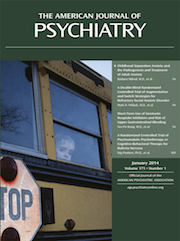A Double-Blind Randomized Controlled Trial of Augmentation and Switch Strategies for Refractory Social Anxiety Disorder
Abstract
Objective
Most patients remain symptomatic after an initial intervention with approved treatments for generalized social anxiety disorder. This randomized controlled trial provides systematic, prospectively derived data on the relative benefits of “next-step” pharmacotherapies to improve outcomes for individuals with generalized social anxiety disorder who remain symptomatic after initial treatment.
Method
This three site, 12-week, double-blind randomized controlled trial compared the relative benefits of three strategies for patients remaining symptomatic (Liebowitz Social Anxiety Scale [LSAS] score >50) after a 10-week trial of sertraline alone: the addition of up to 3.0 mg/day of clonazepam (sertraline plus clonazepam), a switch to up to 225 mg/day of venlafaxine, or prolonged sertraline treatment with placebo (sertraline plus placebo).
Results
A total of 397 participants received at least one dose of sertraline; 181 nonresponders (LSAS score >50) at week 10 were randomly assigned to sertraline plus clonazepam, switch to venlafaxine, or sertraline plus placebo. Overall, 21% of patients achieved remission (LSAS score ≤30) at the endpoint, and 27% of patients assigned to sertraline plus clonazepam achieved remission compared with patients assigned to sertraline plus placebo (17%) or venlafaxine (19%), but the differences did not reach significance. Sertraline plus clonazepam was associated with a significantly greater drop in LSAS severity (p=0.020) and disability (p=0.0028) compared with sertraline plus placebo; no significant differences were observed on these parameters between venlafaxine and either sertraline plus placebo or sertraline plus clonazepam. In supplemental analysis, the overall response rate (LSAS score ≤50) was 46%, including a significantly greater proportion of patients in the sertraline plus clonazepam group (56%) compared with the sertraline plus placebo group responding (36%; p=0.027); differences did not reach significance between venlafaxine and sertraline plus placebo or sertraline plus clonazepam.
Conclusions
The findings suggest that the clonazepam augmentation strategy provides relative benefits for sertraline nonresponders in social anxiety disorder.



